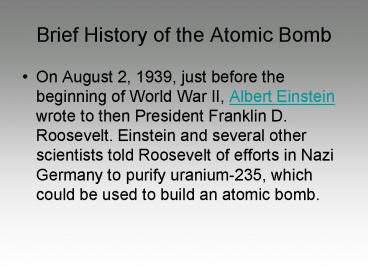Brief History of the Atomic Bomb PowerPoint PPT Presentation
1 / 15
Title: Brief History of the Atomic Bomb
1
Brief History of the Atomic Bomb
- On August 2, 1939, just before the beginning of
World War II, Albert Einstein wrote to then
President Franklin D. Roosevelt. Einstein and
several other scientists told Roosevelt of
efforts in Nazi Germany to purify uranium-235,
which could be used to build an atomic bomb.
2
- It was shortly thereafter that the United States
Government began the serious undertaking known
then only as "The Manhattan Project." Simply put,
the Manhattan Project was committed to expediting
research that would produce a viable atomic bomb.
3
- A massive enrichment laboratory/plant was
constructed at Oak Ridge, Tennessee.
4
K-25 PLANT
5
- Over the course of six years, from 1939 to 1945,
more than 2 billion was spent during the history
of the Manhattan Project.
6
- Upon witnessing the explosion, its creators had
mixed reactions. Isidor Rabi felt that the
equilibrium in nature had been upset -- as if
humankind had become a threat to the world it
inhabited. J. Robert Oppenheimer, though ecstatic
about the success of the project, quoted a
remembered fragment from the Bhagavad Gita. "I am
become Death," he said, "the destroyer of worlds
7
- A uranium bomb nicknamed "Little Boy" (despite
weighing in at over four and a half tons) was
dropped on Hiroshima August 6, 1945.
8
- It missed by only 800 feet. At 0816 hours, in an
instant, 66,000 people were killed and 69,000
injured by a 10-kiloton atomic explosion.
9
(No Transcript)
10
(No Transcript)
11
(No Transcript)
12
(No Transcript)
13
- The photograph shows the stone steps of the main
entrance of Sumitomo Bank which is only 250
meters from the hypocenter. It is believed that a
person sat down on the steps facing the direction
of the hypocenter, possibly waiting for the bank
to open. By a flash of the heat rays with
temperatures well over a 1,000 degrees or
possibly 2,000 degrees centigrade, that person
was incinerated on the stone steps.
14
Byproducts of Atomic Bomb Detonations
- While the explosion from an atomic bomb is deadly
enough, its destructive ability doesn't stop
there. Atomic bomb fallout creates another hazard
as well. The rain that follows any atomic
detonation is laden with radioactive particles,
and many survivors of the Hiroshima and Nagasaki
blasts succumbed to radiation poisoning.
15
There will come soft rains and the smell of the
ground, And swallows circling with their
shimmering sound And frogs in the pools singing
at night, And wild plum trees in tremulous
white Robins will wear their feathery
fire, Whistling their whims on a low
fence-wire And not one will know of the war, not
one Will care at last when it is done. Not one
would mind, neither bird nor tree, If mankind
perished utterly And Spring herself, when she
woke at dawn Would scarcely know that we were
gone.

